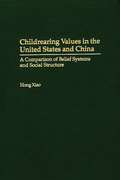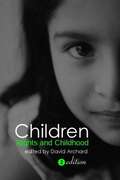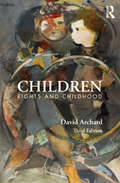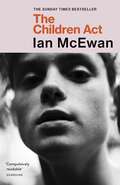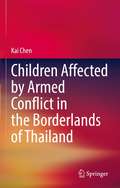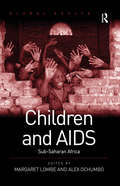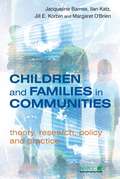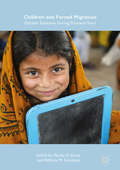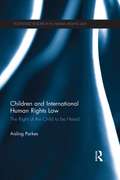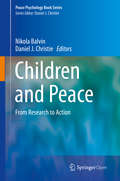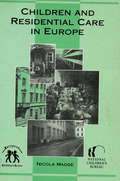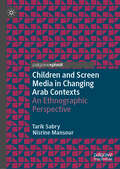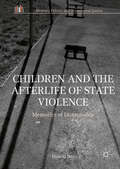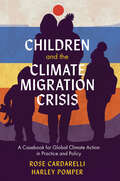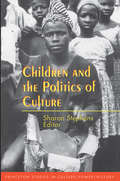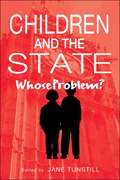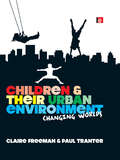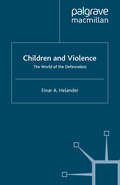- Table View
- List View
Childrearing Values in the United States and China: A Comparison of Belief Systems and Social Structure (Non-ser.)
by Bloomsbury PublishingHong Xiao examines the linkage between social structure and child-rearing values in the United States and China. Her primary objectives are to examine the underlying structure of childrearing values, discover the dynamics of the structural-level, family-level, and individual-level determinants of childrearing values, and to compare patterns of value orientations in the two countries.Three value dimensions--autonomy, conformity, and a care orientation--are identified in both the United States and China samples via factor analyses. Furthermore, despite cross-national differences in political system, economic development, and culture history, Professor Xiao finds Americans and Chinese are quite similar in their thinking of the kinds of things to teach children at home. Among the top six qualities endorsed within each country, five are identical. However, sources of value variations are drastically different in the two countries. For example, in the United States, while the influence of class on men's values for children has become muted overtime, class differences in values continue to exist among women. And neither gender nor motherhood is related to the care orientation. In China, valuation of children's autonomy or conformity is conditioned heavily by political conformity, age, and family size. Of particular interest to scholars, students, and other researchers involved with gender and family studies, sociology, and Asian Studies.
Children: Rights And Childhood
by David ArchardThird / 3rd edition. Children: Rights and Childhood is widely regarded as the first book to offer a detailed philosophical examination of children's rights. Drawing on a wide variety of sources from law and literature to politics and psychology, David Archard provides a clear and accessible introduction to a topic that has assumed increasing relevance since the book's first publication. Divided clearly into three parts, Children: Rights and Childhood covers key topics such as: John Locke's writings on children Philippe Aries's Centuries of Childhood key texts on children's liberation and rights a child's right to vote and to sexual choice the rights of parents and the state over children defining and understanding child abuse. The second edition has been fully revised and updated including a new preface, a new chapter on children's moral and legal rights, taking into account the United Nations Convention on the Rights of the Child.
Children: Rights and Childhood
by David ArchardChildren: Rights and Childhood is widely regarded as the first book to offer a detailed philosophical examination of children’s rights. David Archard provides a clear and accessible introduction to a topic that has assumed increasing relevance since the book’s first publication. Divided clearly into three parts, it covers key topics such as: John Locke’s writings on children Philippe Ariès’s Centuries of Childhood children’s moral and legal rights a child’s right to vote and to sexual choice parental rights to privacy and autonomy defining and understanding child abuse. The third edition has been fully revised and updated throughout with a new chapter providing an in-depth analysis of the United Nations Convention on the Rights of the Child (UNCRC) and Part 2 has been restructured to move the reader from general theoretical considerations of children’s rights through to practical issues. This volume is ideal reading for advanced studies across Philosophy, Social Work, Law, Childhood Studies, Politics, and Social Policy.
Children: Rights and Childhood
by David ArchardChildren: Rights and Childhood is widely regarded as the first book to offer a detailed philosophical examination of children’s rights. David Archard provides a clear and accessible introduction to a topic that has assumed increasing relevance since the book’s first publication. Divided clearly into three parts, it covers key topics such as: John Locke’s writings on children Philippe Ariès’s Centuries of Childhood children’s moral and legal rights a child’s right to vote and to sexual choice parental rights to privacy and autonomy defining and understanding child abuse. The third edition has been fully revised and updated throughout with a new chapter providing an in-depth analysis of the United Nations Convention on the Rights of the Child (UNCRC) and Part 2 has been restructured to move the reader from general theoretical considerations of children’s rights through to practical issues. This volume is ideal reading for advanced studies across Philosophy, Social Work, Law, Childhood Studies, Politics, and Social Policy.
The Children Act
by Ian McEwanFiona Maye, a leading High Court judge, renowned for her fierce intelligence and sensitivity is called on to try an urgent case. For religious reasons, a seventeen-year-old boy is refusing the medical treatment that could save his life. Time is running out.She visits the boy in hospital – an encounter which stirs long-buried feelings in her and powerful new emotions in the boy. But it is Fiona who must ultimately decide whether he lives or dies and her judgement will have momentous consequences for them both.
Children Affected by Armed Conflict in the Borderlands of Thailand
by Kai ChenThis book explores how children have been affected by armed conflict in the borderlands of Thailand, particularly in the region abutting the Thailand-Myanmar border, and in the most southern part of Thailand. The author argues that the Thai government has made great efforts to protect children from armed conflict in these borderlands. The author analyzes the obstacles facing the Thai government in protecting children from armed conflict in the borderlands, and advances alternative solutions for how the Thai government might better protect children from armed conflict in the foreseeable future. This book not only opens a window for future research on children affected by armed conflict in the borderlands of Thailand and beyond, but also contributes to the breadth of perspective and depth of expertise in related fields, such as studies of human insecurity. It is relevant to scholars, graduate students, and policymakers interested in the impact of armed conflict on children.
Children and AIDS: Sub-Saharan Africa (Routledge Global Health Series)
by Margaret Lombe Alex OchumboThe disproportional loss of individuals to HIV/AIDS in their most productive years raises concerns over the welfare of surviving members of affected families and communities. One consequence of the rapid increase in adult mortality is the rise in the proportion of children who are orphaned. Sub-Saharan Africa, accounts for about 90 percent of these. Mainly due to the staggering toll of HIV/AIDS, research effort has focused on treatment and prevention. Children have received attention primarily in relation to 'mother to child transmission' and paediatric AIDS. These issues are important and compelling but fail to capture the whole story - the unprecedented surge in the number of children made vulnerable by HIV/AIDS. In this book we reflect on the plight of children classified as vulnerable, review interventions implemented to improve their welfare and grapple with the concept of vulnerability as it relates to human rights and the African child.
Children and AIDS: Sub-Saharan Africa (Routledge Global Health Series)
by Margaret Lombe Alex OchumboThe disproportional loss of individuals to HIV/AIDS in their most productive years raises concerns over the welfare of surviving members of affected families and communities. One consequence of the rapid increase in adult mortality is the rise in the proportion of children who are orphaned. Sub-Saharan Africa, accounts for about 90 percent of these. Mainly due to the staggering toll of HIV/AIDS, research effort has focused on treatment and prevention. Children have received attention primarily in relation to 'mother to child transmission' and paediatric AIDS. These issues are important and compelling but fail to capture the whole story - the unprecedented surge in the number of children made vulnerable by HIV/AIDS. In this book we reflect on the plight of children classified as vulnerable, review interventions implemented to improve their welfare and grapple with the concept of vulnerability as it relates to human rights and the African child.
Children and Families in Communities: Theory, Research, Policy and Practice (Wiley Child Protection & Policy Series #10)
by Jacqueline Barnes Ilan Barry Katz Jill E. Korbin Margaret O'BrienIn the past decade the relationship between communities, children and families has inspired a wealth of research and policy initiatives because of a growing belief that the breakdown of families and communities is a significant factor in social problems, including child abuse and juvenile crime. The latest policy initiatives to tackle social problems have therefore targeted communities as well as high risk families. This title amalgamates the latest research on the relationship between children, families and communities and explores policy and practice implications. Material for practitioners and community development workers is also be included. The book is divided in to three parts: 1) theory 2) the effect of community on children, parents and families 3) interventions and policy implications.
Children and Forced Migration: Durable Solutions During Transient Years
by Marisa O. Ensor Elżbieta M. GoździakThis book responds to the reality that children and youth constitute a disproportionately large percentage of displaced populations worldwide. It demonstrates how their hopes and aspirations reflect the transient nature of their age group, and often differ from those of their elders. It also examines how they face additional difficulties due to the inconsistent definition and uneven implementation of the traditional ‘durable solutions’ to forced migration implemented by national governments and international assistance agencies. The authors use empirical research findings and robust policy analyses of cases of child displacement across the globe to make their central argument: that the particular challenges and opportunities that displaced children and youth face must be investigated and factored into relevant policy and practice, promoting more sustainable and durable solutions in the process. This interdisciplinary edited collection will appeal to students and scholars of forced migration studies, development, conflict and peace-building and youth studies, along with policy-makers, children's rights organizations and NGOs.
Children and International Human Rights Law: The Right of the Child to be Heard (Routledge Research in Human Rights Law)
by Aisling ParkesThe United Nations Convention on the Rights of the Child 1989 is one of the most highly ratified human rights treaties in the world, with 192 states currently signed up to it. Article Twelve is fundamental to the Convention and states that all children capable of forming views have the right to express those views, and recognises that all children have the right to be heard in any judicial and administrative proceedings affecting them. This book explores the historical and theoretical background to Article Twelve, and examines the various models of participation which have been created to facilitate a better understanding of this provision. Aisling Parkes analyzes the extent to which Article Twelve has been implemented under international law, and in domestic law, as well as setting-out recommendations for the most effective ways of implementing Article Twelve in all areas of children’s lives.
Children and International Human Rights Law: The Right of the Child to be Heard (Routledge Research in Human Rights Law)
by Aisling ParkesThe United Nations Convention on the Rights of the Child 1989 is one of the most highly ratified human rights treaties in the world, with 192 states currently signed up to it. Article Twelve is fundamental to the Convention and states that all children capable of forming views have the right to express those views, and recognises that all children have the right to be heard in any judicial and administrative proceedings affecting them. This book explores the historical and theoretical background to Article Twelve, and examines the various models of participation which have been created to facilitate a better understanding of this provision. Aisling Parkes analyzes the extent to which Article Twelve has been implemented under international law, and in domestic law, as well as setting-out recommendations for the most effective ways of implementing Article Twelve in all areas of children’s lives.
Children and Peace: From Research to Action (Peace Psychology Book Series)
by Nikola Balvin Daniel J. ChristieThis open access book brings together discourse on children and peace from the 15th International Symposium on the Contributions of Psychology to Peace, covering issues pertinent to children and peace and approaches to making their world safer, fairer and more sustainable. The book is divided into nine sections that examine traditional themes (social construction and deconstruction of diversity, intergenerational transitions and memories of war, and multiculturalism), as well as contemporary issues such as Europe’s “migration crisis”, radicalization and violent extremism, and violence in families, schools and communities. Chapters contextualize each issue within specific social ecological frameworks in order to reflect on the multiplicity of influences that affect different outcomes and to discuss how the findings can be applied in different contexts. The volume also provides solutions and hope through its focus on youth empowerment and peacebuilding programs for children and families. This forward-thinking volume offers a multitude of views, approaches, and strategies for research and activism drawn from peace psychology scholars and United Nations researchers and practitioners.This book's multi-layered emphasis on context, structural determinants of peace and conflict, and use of research for action towards social cohesion for children and youth has not been brought together in other peace psychology literature to the same extent. Children and Peace: From Research to Action will be a useful resource for peace psychology academics and students, as well as social and developmental psychology academics and students, peace and development practitioners and activists, policy makers who need to make decisions about the matters covered in the book, child rights advocates and members of multilateral organizations such as the UN.
Children and Residential Care in Europe (PDF)
by Nicola MadgeWhat lessons can be learned from the different ways in which residential care is organised throughout Europe? Which countries' services meet children's needs most effectively? Originally published in 1994, this ebook looks broadly at children and child care services, especially residential child care, in 13 European Union countries, to give an overview of national similarities and differences and identify key areas of change, development and concern. The European Children's Centre survey, on which this report was based, was commissioned by The Warner Inquiry into the selection, development and management of staff in children's homes. Established in the United Kingdom in response to a number of widely-publicised scandals in residential care, the Inquiry recognised the value of looking to other European countries in order to learn from their successes and failures.
Children and Screen Media in Changing Arab Contexts: An Ethnographic Perspective
by Tarik Sabry Nisrine MansourUsing a phenomenological and multi-sited ethnographic approach, this book focuses on children’s uses of digital media in three sites—London, Casablanca and Beirut—and situates the study of Arab children and screen media within a wider frame, making connections between local, regional and global media content. The study moves away from a conventional definition of media towards a pluralistic interpretation, and provides key ethnographic findings that reveal how the notion of home is extended across everyday spaces that children occupy. Exploring the relationship between children and media outside of the subject-object hierarchy, it re-connects them in a horizontal mapping of affectivity and intimacy. This book will appeal to scholars specializing in children and the media, digital media, media and cultural studies, media anthropology, philosophy and Middle Eastern studies.
Children and Spirituality: Searching for Meaning and Connectedness
by Brendan HydeBrendan Hyde identifies four characteristics of children's spirituality: the felt sense, integrating awareness, weaving the threads of meaning, and spiritual questing. These characteristics can be observed in children if those who work with them know what to look for and are alert to the time, place and space in which children find themselves. This book provides ways in which schoolteachers and parents can nurture and foster these particular characteristics of children's spirituality. It also considers two factors, material pursuit and trivialising, which may inhibit children's expression of their spirituality. Children and Spirituality will be of great interest to educators, policy makers, parents, and others who work with and seek to nurture the spirituality of children.
Children and Spirituality: Searching for Meaning and Connectedness (PDF)
by Brendan HydeBrendan Hyde identifies four characteristics of children's spirituality: the felt sense, integrating awareness, weaving the threads of meaning, and spiritual questing. These characteristics can be observed in children if those who work with them know what to look for and are alert to the time, place and space in which children find themselves. This book provides ways in which schoolteachers and parents can nurture and foster these particular characteristics of children's spirituality. It also considers two factors, material pursuit and trivialising, which may inhibit children's expression of their spirituality. Children and Spirituality will be of great interest to educators, policy makers, parents, and others who work with and seek to nurture the spirituality of children.
Children and the Afterlife of State Violence: Memories of Dictatorship (Memory Politics and Transitional Justice)
by Daniela JaraThis book examines memories of political violence in Chile after the 1973 coup and a 17-years-long dictatorship. Based on individual and group interviews, it focuses on the second generation children, adults today, born to parents who were opponents of Pinochet´s regime. Focusing on their lived experience, the intersection between private and public realms during Pinochet’s politics of fear regime, and the afterlife of violence in the post-dictatorship, the book is concerned with new dilemmas and perspectives that stem from the intergenerational transmission of political memories. It reflects critically on the role of family memories in the broader field of memory in Chile, demonstrating the dynamics of how later generations appropriate and inhabit their family political legacies. The book suggests how the second generation cultural memory redefines the concept of victimhood and propels society into a broader process of recognition.
Children and the Climate Migration Crisis: A Casebook for Global Climate Action in Practice and Policy
by Rose Cardarelli Harley PomperWith climate disasters expected to displace millions as the planet continues to warm, we are fast approaching a serious humanitarian crisis. Foregrounding how our children are increasingly shouldering the era-defining effects of climate change, Children and the Climate Migration Crisis chronicles our collective responsibility to address resulting consequences for the wellbeing and future of children everywhere. Using illustrative case studies to dive deeper into the current situation, Rose Cardarelli and Harley Pomper outline an educational response for mitigating climate migration and stress-related trauma, including how to foster the development of the social and emotional strengths and responses that children need to grapple with a world in jeopardy. Subverting eco-anxiety and establishing ways we can empower children around the globe, Children and the Climate Migration Crisis takes a holistic approach to bring together the relevancy and impact of forced migration and climate resilience, underpinned by a social emotional approach to overall wellbeing, adjustment, and adaptability.
Children and the Climate Migration Crisis: A Casebook for Global Climate Action in Practice and Policy
by Rose Cardarelli Harley PomperWith climate disasters expected to displace millions as the planet continues to warm, we are fast approaching a serious humanitarian crisis. Foregrounding how our children are increasingly shouldering the era-defining effects of climate change, Children and the Climate Migration Crisis chronicles our collective responsibility to address resulting consequences for the wellbeing and future of children everywhere. Using illustrative case studies to dive deeper into the current situation, Rose Cardarelli and Harley Pomper outline an educational response for mitigating climate migration and stress-related trauma, including how to foster the development of the social and emotional strengths and responses that children need to grapple with a world in jeopardy. Subverting eco-anxiety and establishing ways we can empower children around the globe, Children and the Climate Migration Crisis takes a holistic approach to bring together the relevancy and impact of forced migration and climate resilience, underpinned by a social emotional approach to overall wellbeing, adjustment, and adaptability.
Children and the Politics of Culture (PDF)
by Edited by Sharon StephensThe bodies and minds of children--and the very space of children--are under assault. This is the message we receive from daily news headlines about violence, sexual abuse, exploitation, and neglect of children, and from a proliferation of books in recent years representing the domain of contemporary childhood as threatened, invaded, polluted, and "stolen" by adults. Through a series of essays that explore the global dimensions of children at risk, an international group of researchers and policymakers discuss the notion of children's rights, and in particular the claim that every child has a right to a cultural identity. Explorations of children's situations in Japan, Korea, Singapore, South Africa, England, Norway, the United States, Brazil, and Germany reveal how children's everyday lives and futures are often the stakes in contemporary battles that adults wage over definitions of cultural identity and state cultural policies. Throughout this volume, the authors address the complex and often ambiguous implications of the concept of rights. For example, it may be used to defend indigenous children from radically assimilationist or even genocidal state policies; but it may also be used to legitimate racist institutions. A substantive introduction by the editor examines global political economic frameworks for the cultural debates affecting children and traces intriguing, sometimes surprising, threads throughout the papers. In addition to the editor, the contributors are Norma Field, Marilyn Ivy, Mary John, Hae-joang Cho, Saya Shiraishi, Vivienne Wee, Pamela Reynolds, Kathleen Hall, Ruth Mandel, Manuela Carneiro da Cunha, and Njabulo Ndebele.
Children and the State
by Jane TunstillIn the consciousness of politicians, professionals and the public, children and young people loom increasingly large as a challenge to be faced. This problematic image includes not only the inevitable and traditional difficulties faced by the young in negotiating a role in society, but also an increasing tendency for children to be problematized, even vilified, and for state intervention in their lives to reflect this trend. Indeed, the increasing scale and scope of central and local government policy responses to the age group can sometimes result, both intentionally and unintentionally, in additional challenges for children to overcome. The text starts with the assumption that we cannot assume that state intervention in the lives of young people will always lead to positive outcomes. The contributors explore the key policy areas such as health, education and the youth justice system, within the broader social and economic context, including race and culture, the economy and European integration.
Children and their Urban Environment: Changing Worlds
by Claire Freeman Paul TranterIn our fast-changing urban world, the impacts of social and environmental change on children are often overlooked. Children and their Urban Environment examines these impacts in detail, looking at the key activities, spaces and experiences children have and how these can be managed to ensure that children benefit from change. The authors highlight the importance of planners, architects and housing professionals in creating positive environments for children and involving them in the planning process. They argue that children‘s lives are becoming simultaneously both richer and more deprived, and that, despite apparently increasing wealth, disparities between children are increasing further. Each chapter includes international examples of good practice and policy innovations for redressing the balance in favour of child supportive environments. The book seeks to embrace childhood as a time of freedom, social engagement and environmental adventure and to encourage creation of environments that better meet the needs of children. The authors argue that in doing so, we will build more sustainable neighbourhoods, cities and societies for the future.
Children and their Urban Environment: Changing Worlds
by Claire Freeman Paul TranterIn our fast-changing urban world, the impacts of social and environmental change on children are often overlooked. Children and their Urban Environment examines these impacts in detail, looking at the key activities, spaces and experiences children have and how these can be managed to ensure that children benefit from change. The authors highlight the importance of planners, architects and housing professionals in creating positive environments for children and involving them in the planning process. They argue that children‘s lives are becoming simultaneously both richer and more deprived, and that, despite apparently increasing wealth, disparities between children are increasing further. Each chapter includes international examples of good practice and policy innovations for redressing the balance in favour of child supportive environments. The book seeks to embrace childhood as a time of freedom, social engagement and environmental adventure and to encourage creation of environments that better meet the needs of children. The authors argue that in doing so, we will build more sustainable neighbourhoods, cities and societies for the future.
Children and Violence: The World of the Defenceless
by E. HelanderThis book provides a disturbing account of the reality of child abuse. Based on data from 152 countries, Einar Helander considers the physical, societal, economic and judicial consequences of child abuse, proposing a universal, community-based prevention programme.
